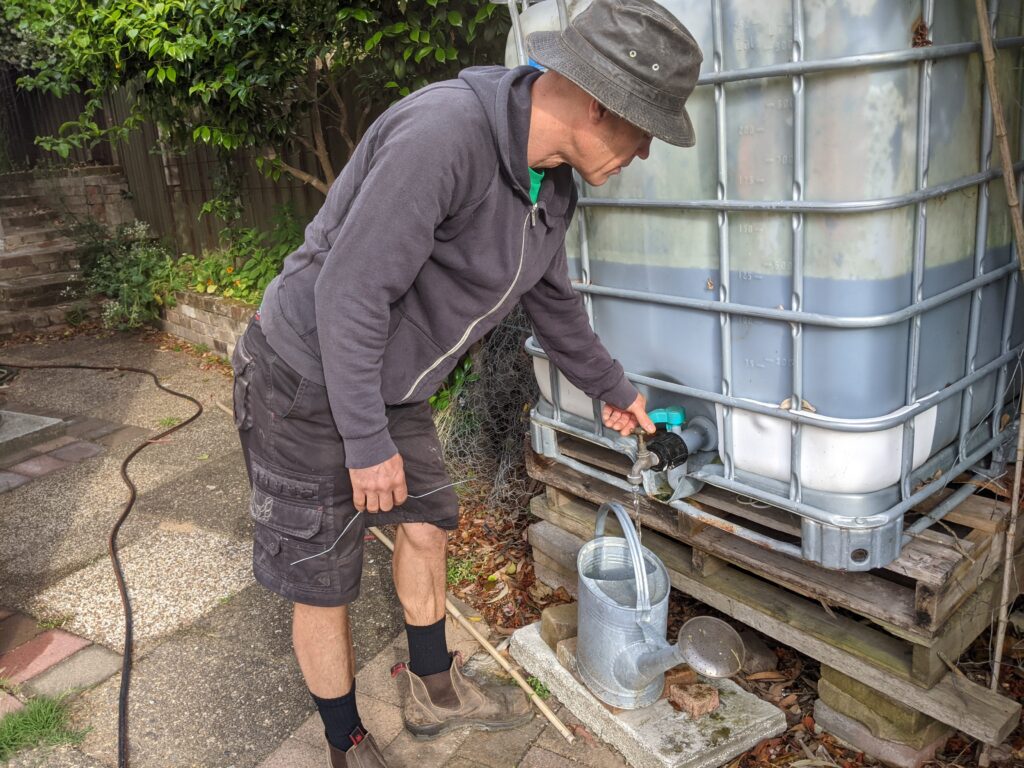In order to make your garden thrive, not just survive, and to give hungry annual veggies and fruit trees the leg up they need to be productive, a little fertilizer makes all the difference.
Home made fertilizer that is ‘alive’ with beneficial bacteria makes even more difference. There are a myriad of ways in which to make your own, and here I’m sharing how I make seaweed tea in bulk – about 1,000 litres.
It doesn’t have to be seaweed, you can also use any old weeds, as long as the weeds are submerged during the decomposition process they should lose their viability to resprout. A good way of recycling stuff onsite that would end up in the green bin. Also don’t get too carried away with exact measuring of ingredients. I’m using the equivalent of about two jam packed 20 lite buckets of greenery to end up with 1,000 litres of fertilizer. Give it a go and experiment. If you think it will be too strong, just dilute it down with more water when you put it in the watering can.
I had heard that collecting seaweed may not be allowed so I did my research first. I think I’m going to end up saying this in every article I write, but doing your research is important!
The first thing that came up was this fantastic article by Diego Bonetto (look him up – brilliant). In NSW you are allowed to take up to 20kg per day for your own use.
https://www.diegobonetto.com/blog/golden-kelp-how-to-collect-and-use-edible-seaweeds
But I didn’t just want to take his word for it. So I dug a little deeper and came up with this straight from the Department of Primary Industries. Good news, as with most things, Diego is on the money.
The seaweed you want is the ‘still moist, fresh from the high tide slimy’ stuff, not the ‘crispy, sat on the beach for a week in the scorching sun’ stuff. If you are lucky enough to have multiple species of seaweed to collect, then variety is the spice of life.
Assuming you’ve taken some deep breaths of the salty sea air and brought home a large bucket of seaweed, there is a bit of preparation to do before you get stuck in. I’m not exactly sure if you need to do this step, but it makes sense to me to get rid of the bulk of the salt from the ocean. First, wash all the sand off with a hose somewhere you don’t mind the accompanying salty residue ending up. Then, I put all the seaweed in a large vessel and fill with fresh water. Make sure the seaweed is all submerged and leave it for a day to dissolve most of the salt. Once you have rinsed it off, you are ready to go.
You can just make this brew with seaweed, but I have plentiful supplies of comfrey and worm castings that I use to juice things up a bit. In this batch I also added yarrow. Place your ingredients in something akin to a calico bag that you can use just like a tea bag.
Whichever large vessel you use to make this concoction, having a tap to decant the resulting goodness is heavily recommended. I make bulk tea in an old food grade IBC which has one limitation – the narrow opening in the top. If you are using a 200 litre drum with a large opening you could just use one bag. But I have to split the ingredients into four and put four separate small tea bags in just so they can get through the hole. I tie a piece of sturdy rope around each one so that I can pull the tea bag out later. The rope is also useful for jiggling the mixture every few days and giving the bacteria the air they need to proliferate.
I tie the rope off to the edge of the IBC so that it doesn’t disappear into the container – I would hate to have to fish one of these tea bags out later…
The next step is to add water to the container up to about a tenth to a fifth of its total volume. The water will seep into the tea bag and nature will work its magic. Agitating the soup at the bottom every third day or so will speed up decomposition, but I generally leave it for about six weeks. The smell after a week will be worse than a teenage boy’s bedroom, but it will gradually dissipate to only slightly nauseating. Leaving the barrel to mature underneath the kitchen window is not recommended.
After six weeks is up, remove the tea bags, fill the vessel up to the top with water and mix. The spent tea bag contents are ideal for the compost.
Voila! Weed tea all diluted down, ready for the watering can. Apply once a fortnight to already moist soil or as a foliar spray (spray all the leaves) on an overcast day and your garden will love you for it.


